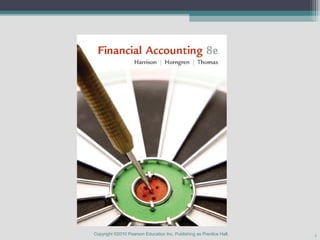
Hhtfa8e ch11 stud devry Accounting 212 FINANCIAL ACCOUNTING
- 1. Copyright ©2010 Pearson Education Inc. Publishing as Prentice Hall. 1
- 2. Copyright ©2010 Pearson Education Inc. Publishing as Prentice Hall. 2
- 3. The Income Statement & Statement of Stockholders’ Equity Chapter 11 Copyright ©2010 Pearson Education Inc. Publishing as Prentice Hall. 3
- 4. Analyze a corporate income statement Copyright ©2010 Pearson Education Inc. Publishing as Prentice Hall. 4
- 5. Earnings Quality Copyright ©2010 Pearson Education Inc. Publishing as Prentice Hall. 5
- 6. Revenue Recognition • Revenue is recognized when earned Copyright ©2010 Pearson Education Inc. Publishing as Prentice Hall. 6
- 7. Cost of Goods Sold and Gross Profit Copyright ©2010 Pearson Education Inc. Publishing as Prentice Hall. 7
- 8. Operating and Other Expenses • Largest operating expenses include salaries, wages, utilities and supplies • Interest expense represents charges for borrowed money • Interest revenue represents return earned on invested money • Income tax expense Copyright ©2010 Pearson Education Inc. Publishing as Prentice Hall. 8
- 9. Operating Earnings Copyright ©2010 Pearson Education Inc. Publishing as Prentice Hall. 9
- 10. Value of Corporate Stock Estimated Estimated future annual income value of common stock Investment capitalization rate Number of Current Current common market market value shares price per of company outstanding share Copyright ©2010 Pearson Education Inc. Publishing as Prentice Hall. 10
- 11. Investment Decision Rule If the estimated value Decision of the company Buy the stock because the Exceeds price may go up Current market value Hold the stock because Equals of the the price will hold steady company Sell the stock because the Is less than price may go down Copyright ©2010 Pearson Education Inc. Publishing as Prentice Hall. 11
- 12. Discontinued Operations • Sale or closure of a business segment • Gain or loss reported net of income tax • Typically not considered by analysts in making predictions Copyright ©2010 Pearson Education Inc. Publishing as Prentice Hall. 12
- 13. Accounting Changes Change in estimates Change in principles • Examples: • Example: ▫ Estimated life of plant ▫ Change in inventory asset method (FIFO to LIFO) ▫ Percent uncollectible of receivables • Report new amounts for • Report retrospectively current and future ▫ Prior period amounts periods are restated Copyright ©2010 Pearson Education Inc. Publishing as Prentice Hall. 13
- 14. Earnings per Share (EPS) Net income minus Preferred Dividends Average # of Common Shares Outstanding Key measure of business success Copyright ©2010 Pearson Education Inc. Publishing as Prentice Hall. 14
- 15. Exercise 11-16A Preferred stock $60 par, 3%, 12,000 shares issued Common stock, $0.75 par, 1,100,000 shares issued Treasury stock, common, 90,000 shares at cost Preferred Dividend = $720,000 x 3% ? Common shares outstanding = ? shares issued less treasury shares Copyright ©2010 Pearson Education Inc. Publishing as Prentice Hall. 15
- 16. Exercise 11-16A Net Income minus Preferred Dividends Earnings per share Average # of Common Shares Outstanding ? ? ? Copyright ©2010 Pearson Education Inc. Publishing as Prentice Hall. 16
- 17. Account for a corporation’s income tax Copyright ©2010 Pearson Education Inc. Publishing as Prentice Hall. 17
- 18. Corporate Income Taxes Income tax Income Income tax expense before taxes rate Income Statement From the Income account Statement Income tax Taxable Income tax payable income rate Balance sheet From the tax account return Copyright ©2010 Pearson Education Inc. Publishing as Prentice Hall. 18
- 19. Exercise 11-18A Quinn Advertising Inc. Income Statement (partial) For year ending December 31, 2010 Income before income tax Income tax expense (375,000 x 30%) Net Income Copyright ©2010 Pearson Education Inc. Publishing as Prentice Hall. 19
- 20. Exercise 11-18A Quinn Advertising, Inc. Balance Sheet (partial) December 31, 2010 Current liabilities: Income tax payable (300,000 x 30%) Long-term liabilities: Deferred tax liability (112,500 – 90,000) Copyright ©2010 Pearson Education Inc. Publishing as Prentice Hall. 20
- 21. Correcting Retained Earnings • Prior period adjustments ▫ Revenue or expense recorded incorrectly in an earlier period ▫ Correction of error adjusts beginning balance of retained earnings Copyright ©2010 Pearson Education Inc. Publishing as Prentice Hall. 21
- 22. Comprehensive Income • Change in total stockholders’ equity from all non-owner sources • Net income plus: ▫ Unrealized gains (losses) on available-for-sale investments ▫ Foreign-currency translation adjustments Copyright ©2010 Pearson Education Inc. Publishing as Prentice Hall. 22
- 23. Analyze a statement of stockholders’ equity Copyright ©2010 Pearson Education Inc. Publishing as Prentice Hall. 23
- 24. Statement of Stockholders’ Equity • Column for each element of equity Accumulated other Common Additional Retained comprehensive Treasury stock paid-in capital earnings income stock • Row for each transaction that affected equity Beginning balance + Net earnings + or – Accumulated other comprehensive income + Issuance of stock - Repurchase of stock - Dividends Copyright ©2010 Pearson Education Inc. Publishing as Prentice Hall. 24
- 25. Understand managers’ and auditors’ responsibilities for the financial statements Copyright ©2010 Pearson Education Inc. Publishing as Prentice Hall. 25
- 26. Management’s Responsibility • Issues report on and declares responsibility for internal control over financial reporting • States it has conducted an assessment of internal controls based on developed frameworks Copyright ©2010 Pearson Education Inc. Publishing as Prentice Hall. 26
- 27. Auditor’s Report • CPAs examine financial statements of publicly- traded companies • Auditors determine if statements comply with GAAP • Combined report issued on the financial statements and system of internal controls • Audit adds credibility to financial statements and internal control system Copyright ©2010 Pearson Education Inc. Publishing as Prentice Hall. 27
- 28. Copyright ©2010 Pearson Education Inc. Publishing as Prentice Hall. 28